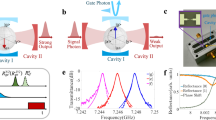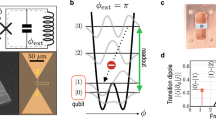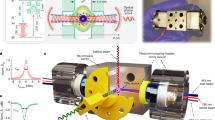Abstract
Superconducting qubits1,2 behave as artificial two-level atoms and are used to investigate fundamental quantum phenomena. In this context, the study of multiphoton excitations3,4,5,6,7 occupies an important role. Moreover, coupling superconducting qubits to onchip microwave resonators has given rise to the field of circuit quantum electrodynamics8,9,10,11,12,13,14,15 (QED). In contrast to quantum-optical cavity QED (refs 16, 17, 18, 19), circuit QED offers the tunability inherent to solid-state circuits. Here, we report on the observation of key signatures of a two-photon-driven Jaynes–Cummings model, which unveils the upconversion dynamics of a superconducting flux qubit20 coupled to an on-chip resonator. Our experiment and theoretical analysis show clear evidence for the coexistence of one- and two-photon-driven level anticrossings of the qubit–resonator system. This results from the controlled symmetry breaking of the system hamiltonian, causing parity to become a not-well-defined property21. Our study provides fundamental insight into the interplay of multiphoton processes and symmetries in a qubit–resonator system.
This is a preview of subscription content, access via your institution
Access options
Subscribe to this journal
Receive 12 print issues and online access
$259.00 per year
only $21.58 per issue
Buy this article
- Purchase on SpringerLink
- Instant access to full article PDF
Prices may be subject to local taxes which are calculated during checkout




Similar content being viewed by others
References
Makhlin, Y., Schön, G. & Shnirman, A. Quantum-state engineering with Josephson-junction devices. Rev. Mod. Phys. 73, 357–400 (2001).
Wendin, G. & Shumeiko, V. S. in Handbook of Theoretical and Computational Nanotechnology Vol. 3 (eds Rieth, M. & Schommers, W.) 223–309 (American Scientific Publishers, Los Angeles, 2006).
Nakamura, Y., Pashkin, Yu. A. & Tsai, J. S. Rabi oscillations in a Josephson-junction charge two-level system. Phys. Rev. Lett. 87, 246601 (2001).
Oliver, W. D. et al. Mach–Zehnder interferometry in a strongly driven superconducting qubit. Science 310, 1653–1657 (2005).
Saito, S. et al. Parametric control of a superconducting flux qubit. Phys. Rev. Lett. 96, 107001 (2006).
Sillanpää, M., Lehtinen, T., Paila, A., Makhlin, Y. & Hakonen, P. J. Continuous-time monitoring of Landau–Zener interference in a Cooper-pair box. Phys. Rev. Lett. 96, 187002 (2006).
Wilson, C. M. et al. Coherence times of dressed states of a superconducting qubit under extreme driving. Phys. Rev. Lett. 98, 257003 (2007).
Wallraff, A. et al. Strong coupling of a single photon to a superconducting qubit using circuit quantum electrodynamics. Nature 431, 162–167 (2004).
Chiorescu, I. et al. Coherent dynamics of a flux qubit coupled to a harmonic oscillator. Nature 431, 159–162 (2004).
Johansson, J. et al. Vacuum Rabi oscillations in a macroscopic superconducting qubit LC oscillator system. Phys. Rev. Lett. 96, 127006 (2006).
Houck, A. A. et al. Generating single microwave photons in a circuit. Nature 449, 328–331 (2007).
Astafiev, O. et al. Single artificial-atom lasing. Nature 449, 588–590 (2007).
Sillanpää, M. A., Park, J. I. & Simmonds, R. W. Coherent quantum state storage and transfer between two phase qubits via a resonant cavity. Nature 449, 438–442 (2007).
Majer, J. et al. Coupling superconducting qubits via a cavity bus. Nature 449, 443–447 (2007).
Wallraff, A. et al. Sideband transitions and two-tone spectroscopy of a superconducting qubit strongly coupled to an on-chip cavity. Phys. Rev. Lett. 99, 050501 (2007).
Thompson, R. J., Rempe, G. & Kimble, H. J. Observation of normal-mode splitting for an atom in an optical cavity. Phys. Rev. Lett. 68, 1132–1135 (1992).
Mabuchi, H. & Doherty, A. C. Cavity quantum electrodynamics: coherence in context. Science 298, 1372–1377 (2002).
Haroche, S. & Raimond, J.-M. Exploring the Quantum (Oxford Univ. Press, New York, 2006).
Walther, H., Varcoe, B. T. H., Englert, B.-G. & Becker, T. Cavity quantum electrodynamics. Rep. Prog. Phys. 69, 1325–1382 (2006).
Orlando, T. P. et al. Superconducting persistent-current qubit. Phys. Rev. B 60, 15398–15413 (1999).
Liu, Y-X, You, J. Q., Wei, L. F., Sun, C. P. & Nori, F. Optical selection rules and phase-dependent adiabatic state control in a superconducting quantum circuit. Phys. Rev. Lett. 95, 087001 (2005).
Blais, A., Huang, R.-S., Wallraff, A., Girvin, S. M. & Schoelkopf, R. J. Cavity quantum electrodynamics for superconducting electrical circuits: An architecture for quantum computation. Phys. Rev. A 69, 062320 (2004).
Simmonds, R. W. et al. Decoherence in Josephson phase qubits from junction resonators. Phys. Rev. Lett. 93, 077003 (2004).
Deppe, F. et al. Phase coherent dynamics of a superconducting flux qubit with capacitive bias readout. Phys. Rev. B 76, 214503 (2007).
Kakuyanagi, K. et al. Dephasing of a superconducting flux qubit. Phys. Rev. Lett. 98, 047004 (2007).
Mariantoni, M. et al. On-chip microwave Fock states and quantum homodyne measurements. Preprint at <http://arxiv.org/abs/cond-mat/0509737> (2005).
Liu, Y-X, Wei, L. F. & Nori, F. Generation of non-classical photon states using a superconducting qubit in a microcavity. Europhys. Lett. 67, 941–947 (2004).
Moon, K. & Girvin, S. M. Theory of microwave parametric down-conversion and squeezing using circuit QED. Phys. Rev. Lett. 95, 140504 (2005).
Cohen-Tannoudji, C., Diu, B. & Laloë, F. Quantum Mechanics (Wiley–Interscience, New York, 1977).
Buckel, W. & Kleiner, R. Superconductivity (Wiley–VCH, Berlin, 2004).
Acknowledgements
We thank H. Christ for fruitful discussions. This work is supported by the Deutsche Forschungsgesellschaft through the Sonderforschungsbereich 631. Financial support by the Excellence Cluster ‘Nanosystems Initiative Munich (NIM)’, the EuroSQIP EU project, the Ikerbasque Foundation and UPV-EHU Grant GIU07/40 is gratefully acknowledged. This work is partially supported by CREST-JST, JSPS-KAKENHI(18201018) and MEXT-KAKENHI(18001002).
Author information
Authors and Affiliations
Corresponding author
Rights and permissions
About this article
Cite this article
Deppe, F., Mariantoni, M., Menzel, E. et al. Two-photon probe of the Jaynes–Cummings model and controlled symmetry breaking in circuit QED. Nature Phys 4, 686–691 (2008). https://doi.org/10.1038/nphys1016
Received:
Accepted:
Published:
Issue date:
DOI: https://doi.org/10.1038/nphys1016
This article is cited by
-
Depiction of an external classical field effects on a four-level W-configuration atom embedded in a coherent cavity field
Applied Physics B (2023)
-
Dynamical photon–photon interaction mediated by a quantum emitter
Nature Physics (2022)
-
Dynamical Properties of the Field In Generalized Photon-Added Pair Coherent State in the Jaynes-Cummings Model
International Journal of Theoretical Physics (2022)
-
Amplitude and frequency sensing of microwave fields with a superconducting transmon qudit
npj Quantum Information (2020)
-
Cross Phase Modulation in a Δ-type Three-Level System
International Journal of Theoretical Physics (2020)



